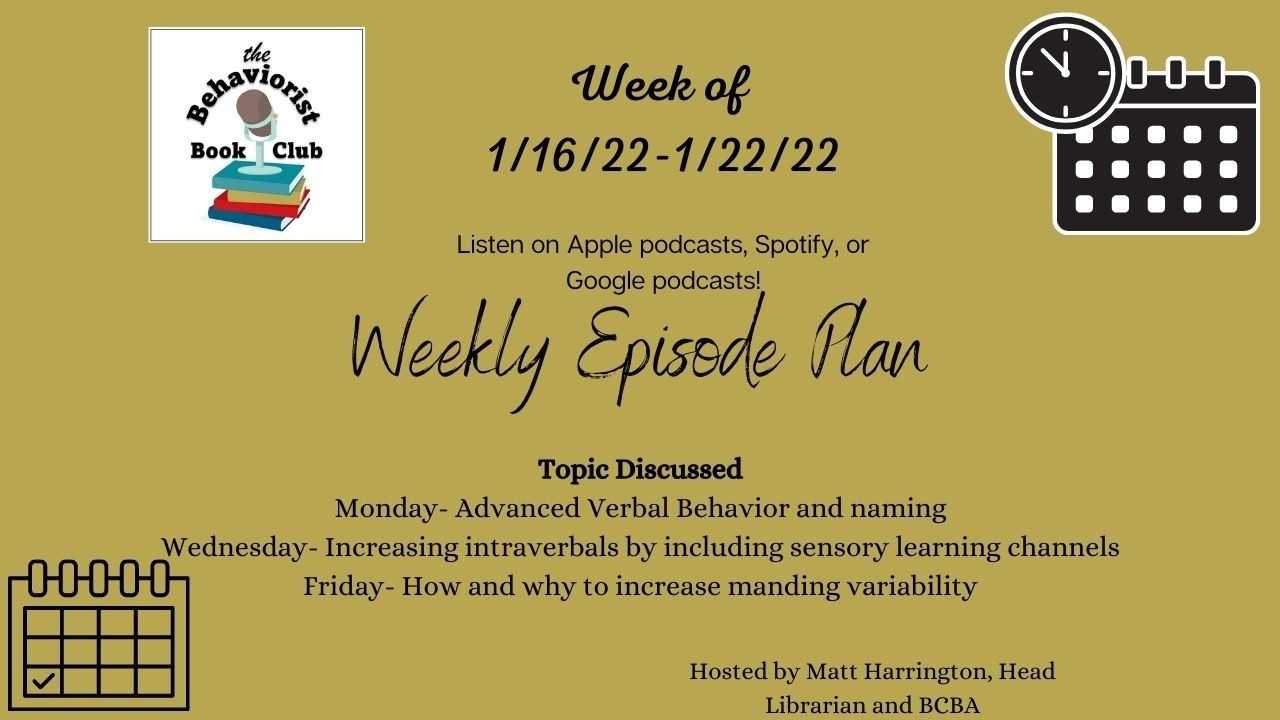Weekly Episode Plan- 1/16/22- 1/22/22
Jan 15, 2022
Hey there behaviorists!
Welcome to another full week of podcasts and behavior analysis! We are continuing our foray in the Analysis of Verbal Behavior and discussing some interesting topics this week! On the docket, we have some pretty advanced verbal behavior. Everything from stimulus equivalence, naming, learning channels, and behavioral variability, this is sure to be a fun week for the ABA nerds like myself. Continue reading below for some more details, and I hope you tune in!
Monday
Advanced verbal behavior; Naming and stimulus equivalence
Stimulus equivalence theory is one of those things that behavior analysts either love or hate. In fact, one of my favorite behavior analysts that I have met had the stimulus equivalence paradigm tattooed on their arm. Personally, I love it, because I think it gives us as behavior analysts the answer to the question of generative language development. Is it the whole answer? Probably not, but it is at least a start. In this article, the continue the exploration of stimulus equivalence by comparing the acquisition of match to sample tasks when common and individual naming is taught. Naming is when a stimulus is given a “name” such as naming a pencil “pencil”. The reason this concept is important is because there is some evidence to support that an individual must be able to name a stimulus before acquiring symmetry, transitivity, and reflexivity. This article explores all of these topics, with some great practical steps for the behavior analyst at the end! I hope you enjoy.
Granerud, G., & Arntzen, E. (2021). Naming of stimuli in equivalence class formation in children. Analysis Verbal Behavior, 37(1), 77–96. https://doi.org/10.1007/s40616-021-00143-8
Wednesday
Intraverbal acquisition; The addition of sensory modalities to a learning channel
In our accidental two-part series, we explore a little discussed topic in verbal behavior. The concept of learning channels and the role of stimulus equivalence training. A learning channel is essentially the classification of a prompt or task based on the types of sensory modalities that it encompasses. For example, holding up a laminated card and saying, “What is this?” would be an example of a HearSeeSay learning channel. However, there may be evidence to support that the addition of different sensory modalities within a learning channel can increase the acquisition speed of an intraverbal target. These authors attempt to demonstrate this by comparing acquisition speeds of traditional learning channels and learning channels with additional sensory modalities. In a slightly complicated article, the authors dovetail the discussion into a very practical takeaway and makes suggestions for the teaching of intraverbals for kids or adults who have Autism Spectrum Disorder.
Thakore, A., Stockwell, A., & Eshleman, J. (2021). Learning channels: The role of compound stimuli in the emergence of intraverbal relations in children on the autism spectrum. Analysis Verbal Behavior, 37(1), 97–122. https://doi.org/10.1007/s40616-020-00142-1
Friday
Reinforcing behavioral variability in manding
Let’s finish this week strong with a discussion of the concept of variability as it directly relates to manding. The concept of variability is one that perhaps needs to be framed with the disclaimer that… A behavior analyst should not contingently reinforce variability unless the acquisition of variability increases the quality of life of the client being served. If a client and an Analyst agree to target variability, one is left confused on where to start. After all, variability seems more like a concept than a behavior. The purpose of this article is to operationalize and give a review over variability literature and provide some operational definitions for this concept. In addition to clarifying the concept, the authors makes some strong arguments on why we need to be reinforcing and encouraging variability, especially in the context of functional communication training and the reduction of problematic behavior.
Silbaugh, B.C. (2021). Some Dimensions of Mand Variability and Implications for Research and Practice. Analysis Verbal Behavior, 37(1), 123–145. https://doi.org/10.1007/s40616-021-00144-7
Solve your clinical challenges with research using this simple, 3 step process that saves you time and gets you clinical answers FAST.
Learn the Key Places Framework, the Research Finding Framework, and how they work together in this free minicourse.
Signing up will also subscribe you to the email list. Unsubscribe at anytime! We will never sell your information, for any reason.

